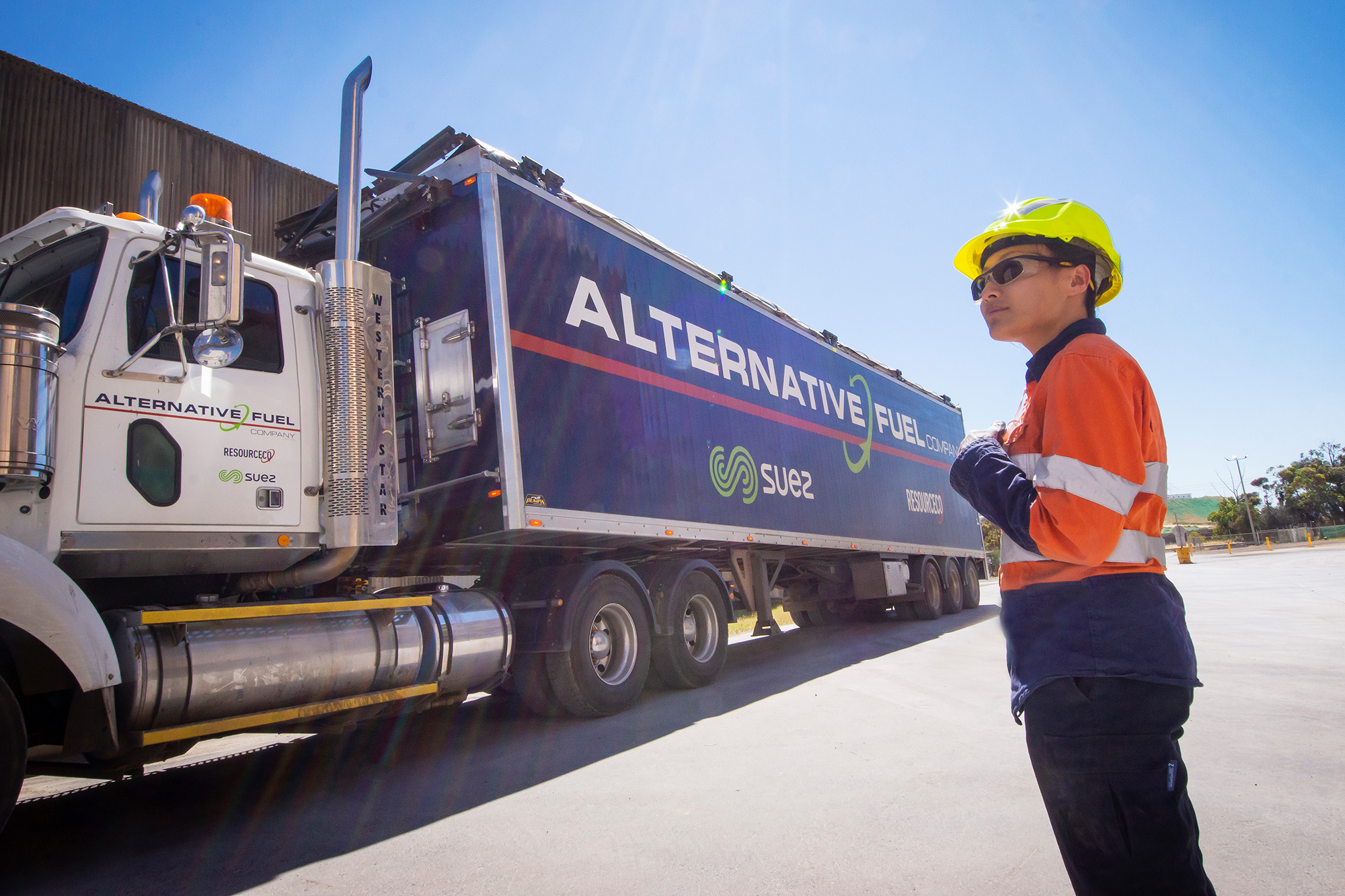Refuse Derived Fuel
RDF is a process engineered fuel, produced from commercial and industrial (C&I) and construction and demolition (C&D) waste (primarily timber), that has been used at the Birkenhead site since 2003.
Material Recovery Facilities, receiving waste from Commercial & Industrial and Construction & Demolition sources remove the recyclable components, leaving a residual waste stream that would normally be sent to landfill. RDF is produced from the waste destined for landfill, which has recyclable materials removed.
The RDF, which also contains some plastics, is burnt at high temperatures and a non combustible fraction which contributes to the process raw materials reducing clay consumption. Burning RDF at high temperatures, in ABC’s process does not change the EPA approved emissions profile of ABC.
Alternative Fuel Use at Adbri Cement

Refuse Derived Fuel
Refuse Derived Fuel (RDF) is refuse from the mixed construction and demolition industry that would otherwise be sent to landfill.
Refuse is diverted and segregated at a specialised third party facility and material that has been appropriately processed is sent to ABC’s Birkenhead plant.
Although ABC was the first organisation to use RDF in Australia, it is a commonly used practice in Europe and North America.
How ABC uses RDF
Cement is one of the most widely used construction materials in the world. ABC’s cement is used to build homes and vital infrastructure throughout South Australia and other parts of Australia.
The production of cement is a highly energy intensive process with kilns requiring temperatures of up to 1600oC in order to produce the cement minerals.
Kilns have traditionally used fossil fuels such as natural gas to achieve these temperatures.
For further information, please see our RDF Fact Sheet or watch this 2019 SA Premiers Award video explaining the use of Alternative Fuels at Adbri Cement:
RDF Research and Approval Process
Following intensive studies, ABC applied to the EPA for an increase in RDF plastic content from 10% up to 20%, to manage the change in RDF resulting from better separation and recovery of heavier recyclable components (typically, sand, brick, rock and concrete) from the demolition waste.
In July 2018 the EPA approved ABC’s application to increase the plastic content in the RDF and amended the Birkenhead licence to permit the use of 15 tonnes per hour of RDF with a maximum of 20% plastic.
The EPA’s decision was based on a thorough review and analysis of the application submitted by ABC which included (all reports available at the bottom of this page):
- The increased plastic content trial methodology, stack emissions testing and results, and the Alternative fuel post-trial report
- The review and verification of information also included advice from the EPA’s Air Quality Scientists and a third-party review by the Victorian EPA
- Confirmation of the use of independent National Association of Testing Authorities (NATA) accredited testing
- Regard to the community submissions on the proposed changes received on this matter, including ABC’s response to the summary of submissions.
- The development of an RDF Recovered Product Plan, approved by the EPA
- Alignment of the licence with the Refuse Derived Fuel standard, which is referenced in the Environment Protection (Waste to Resources) Policy 2010.
25 Tonnes per hour RDF Trial
ABC prepared in accordance with the EPA Licence condition U-703, an Increased Refuse Derived Fuel Addition Pre-Trial Report to trial RDF up to 25 tonnes per hour, which was approved by the EPA in January 2019. (personal and commercially confidential information has been redacted from the report)
ABC commenced the 25 tph RDF trial in May 2019. Several trials were conducted between May and October 2019, to evaluate and prove the capability of RDF feed equipment, kiln process and clinker quality, at increased RDF burn rates. Stack emission testing was undertaken during the final 25 tph trial in October 2019.
A Post -Trial Report – Increased Refuse Derived Fuel Addition up to 25 t/h was prepared and submitted to the EPA. (personal and commercially confidential information has been redacted from the report)
The EPA conducted a thorough review and analysis of the 25 tph RDF trial which included:
- The Alternative Fuel Post – Trial Report – Increased Refuse Derived Fuel Addition up to 25 t/h
- Stack emissions testing and air dispersion modelling undertaken by independent NATA (National Association of Testing Authorities) accredited stack testers
- Comparison of trial emission levels against the last 3 years of pre-trial emission levels to confirm there was no significant increase in stack emissions, including oxides of nitrogen, carbon monoxide, benzene, volatile organic hydrocarbons, dioxins and furans
- Statistical analysis and comparison of RDF plastic levels during the trial with RDF plastics levels following approval in June 2018 (permitting up to 20% plastic), to ensure the RDF used during the trial was typical of normal RDF
- Comparison and analysis of trial and pre-trial; stack emission levels and RDF plastic levels
- Review and comparison of trial and pre-trial operating parameters including combustion gases (carbon monoxide, methane, oxygen) as required by licence condition U-725, to ensure combustion of RDF during the trial was optimised.
ABC submitted to the EPA an Additional Information – Alternative Fuel Post Trial Report Increased Refuse Derived Fuel Addition up to 25 t/h, to include the additional information and analysis requested by the EPA during the review of the 25 tph RDF Trial. (personal and commercially confidential information has been redacted from the report)
In August 2020, the EPA advised ABC that the Alternative Fuels Post-Trial Report – Increased Refuse Derived Fuel Addition up to 25 t/h (which includes the Additional Information – Alternative Fuel Post Trial Report) is to the satisfaction of the EPA.
ABC Summary of the 25 tph RDF Trial
The stack emission tests undertaken during the trial are representative of a typical RDF composition with plastic levels up to 20% plastic, at a 25 tph burn rate.
Modelling of stack emissions measured during the 25 tph trial has shown ground level concentrations of all pollutants to be well below the relevant criteria in the Environment Protection (Air Quality) Policy 2016.
There was no increase in carbon monoxide emissions on 4B stack that would indicate a change in burning conditions in the calciner and incomplete burnout of the RDF. Likewise, the measured concentrations for hydrocarbons, remained within the normal range of variation previously observed, providing further evidence that products of incomplete combustion are not being generated.
The burner management system and process control logic ensure that the combustion of RDF is optimised, minimising the risk of incomplete combustion and associated emissions.
From an operational viewpoint, the trial was effective in providing an understanding of the effect of increased burning rate of RDF in the calciner. The impacts on process operation, the burner management systems, product quality and overall pyro processing circuit were assessed and no impediments to continuing at 25 tph RDF feed rate were found.
The use of RDF at 25 tph with up to 20% plastic is a viable option to reduce the total natural gas and raw material requirements for clinker production whilst also substantially reducing waste to landfill.
Consequently, ABC has applied to the EPA for a variation to the EPA licence to allow the increased use of RDF up to 25 tph with a maximum of 20% plastic. If you have any questions please contact us on 8300 0300 between our normal business hours of 8:30 am to 5pm or Email: BirkenheadCommunity@adbri.com.au
25 tph RDF Process Change Application
Following the EPA acceptance of the 25 tph trial reports ABC submitted a process change application to the SA EPA to permit the use of 25 tph RDF with up to a maximum of 20% plastic.
The process change application process included:
- An EPA site inspection/audit on the use of RDF at ABC’s Birkenhead site, which included storage, testing and quality control. A similar audit/inspection was also undertaken at SUEZ – Resourceco’s RDF production facility in Wingfield.
- ABC reviewed and updated the RDF Recovered Products Plan, to include information from the 25 tph RDF trial.
- EPA, provided public notification of the intent to change the Birkenhead site Licence 1126 to permit the use of 25 tph RDF with 20% plastic on the 14 October 2020.
- ABC and the EPA received no submissions from the public during the 14 day notification period.
Following a thorough review, the EPA approved ABC’s application, and amended the Birkenhead Licence 1126, Schedule X-1, on the 9 November 2020, permitting the use of 25 tph RDF with a maximum of 20% plastic contamination by weight.
32 Tonnes per hour RDF Trial
RDF is a process engineered fuel, produced primarily from construction and demolition waste that has been used at the Birkenhead site since 2003 as an alternative fuel to natural gas.
ABC prepared, in accordance with the Birkenhead EPA Licence 1126 conditions, an Increased Alternative Fuel Substitution Pre-Trial Report, to conduct an alternative fuel trial to determine and demonstrate the ability and benefit of the Birkenhead plant to achieve 100% replacement of fossil fuel input to the calciner with alternative fuel.
The proposed trial was approved by the EPA on the 1 September 2022.
Following EPA approval, the trial was successfully conducted, which included comprehensive stack testing undertaken in December 2022.
The trial demonstrated that ABC have the machinery, supply capacity and process capability to run the calciner with 100% RDF, with no significant impact or change on the normal operation of the combustion process and no increased risk of adverse environmental or human health impacts.
The trial increased the Refuse Derived Fuel (RDF) used in the Birkenhead calciner from about 80% to 100%, which required increasing the use of RDF from 25 tonnes/hour to 32 tonnes/hour.
An Increased Alternative Fuel Substitution Post-Trial Report was submitted in May 2023 to the EPA for review.
In June 2023 the EPA advised ABC that the Increased Alternative Fuel Substitution Post-Trial Report is to the satisfaction of the EPA.
The trial demonstrated that the use of RDF at 32 tph is a viable option to achieve 100% replacement of fossil fuel input to the calciner, reducing the total natural gas and raw material requirements for clinker production whilst also substantially reducing waste to landfill.
Consequently, ABC has now applied to the EPA for a variation to the EPA licence to allow the increased use of RDF up to 32 tph.
Following a thorough review, the EPA approved ABC’s application, and amended the Birkenhead Licence 1126, Schedule X-1, on the 20 November 2023, permitting the use of 32 tph RDF with a maximum of 20% plastic contamination by weight.
If you have any questions, please contact us via: bhcommunity@adbri.com.au
Alternative Fuels EPA reports
Please note – some reports have redacted information, which may be commercially sensitive or detailing personal employee information.
